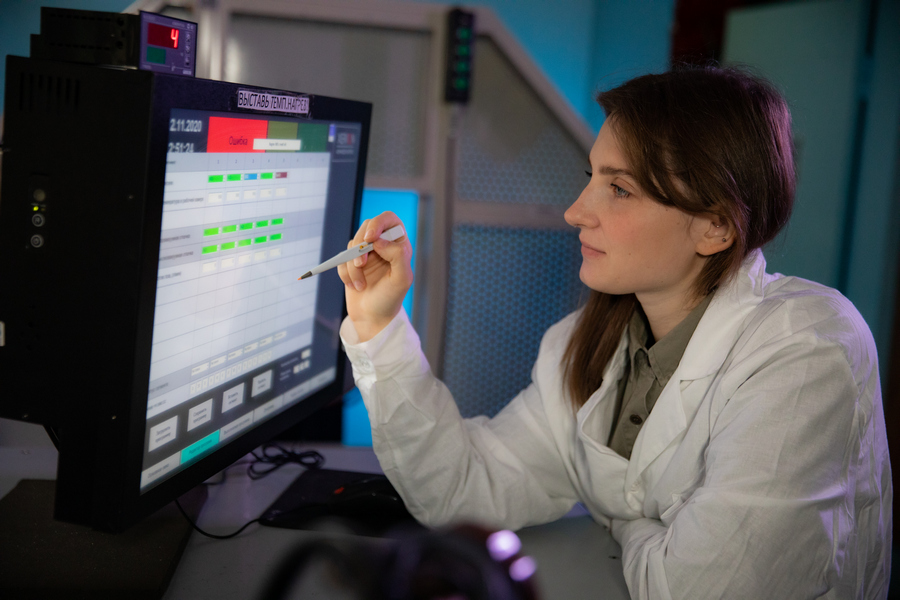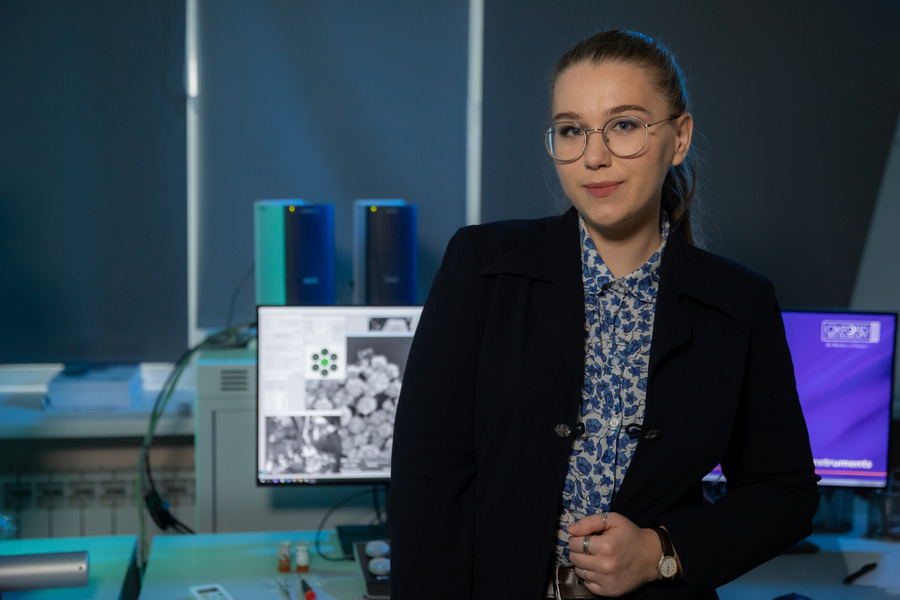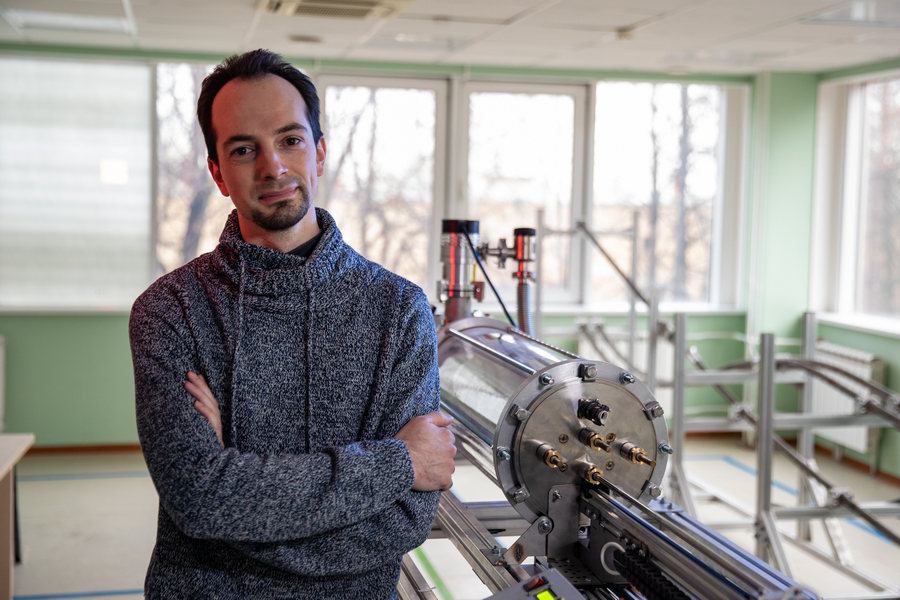Five scientists from National Research Nuclear University MEPhI told us about how they bring the world closer to a revolution in medicine, a breakthrough in thermonuclear energy, a coup in nanotechnology and cybersecurity.
Diana Bachurina
Creates new materials for the DEMO fusion reactor

She is a postgraduate student, an engineer of the Department of Physical Problems of Materials Science. She received a scholarship from the President of the Russian Federation for students and PhD students carrying out promising research and development in priority areas of modernization of the Russian economy. Her hobbies are dancing, snowboarding and yachting.
Currently, 770 million people are living without access to electricity. Another part of people, in 80% of cases, receives electricity by burning fossil fuels, the reserves of which are reducing. Meanwhile, human needs are constantly growing, and it means that by 2100 almost all the Earth inhabitants may live without electricity. To prevent this, scientists are developing a fusion reactor.
The ITER experimental facility will soon start operating, after that construction of the DEMO demonstration reactor will begin. Using it scientists will learn how to convert thermonuclear energy into electrical energy. However, for this purpose, they need to solve many complex scientific problems.
One of those problems is to create new material for DEMO. Modern materials exposed to high temperatures and high-energy radiation fluxes quickly degrade. Only tungsten can be in close proximity to a thermonuclear reaction in DEMO. At the same time, it is impossible to make the entire structure of the reactor using tungsten; steel is used for it. The properties of tungsten and steel are very different, which is why their direct connection is quickly destroyed. Scientists need to get their lasting contact.
— In my work, I use the joint brazing procedure. Of course, Of course, the solder that is sold in stores is not suitable for this. We need complex alloys consisting of titanium, zirconium, copper and even beryllium. My task is to figure out what solder-alloy composition is the most suitable for the DEMO reactor components that can maintain their integrity throughout the whole life cycle of the reactor, which is about 30 years.
Nuclear energy of the future through the eyes of Diana Bachurina:
— Firstly, our future is fusion; secondly, a closed fuel cycle will allow not only to produce waste from nuclear reactors, but also to use it; and, thirdly, tolerant fuel (nuclear fuel that resists emergency situations at NPP). My and my colleagues’ task is to help bring this to the future.
Speaking about the material science of fusion reactors, perhaps, all efforts should be devoted to the development of tungsten and its alloys. This is the main material for a fusion reactor; unfortunately, it has many disadvantages.
Women in Nuclear Physics:
—Regardless of gender, if you are interested in nuclear physics, you need to start doing it. I do not see any difference between women and men in science.
For example, we have many girls in our laboratory. Some people even joke that materials science is the area of science that girls are better at because of our accuracy. Although I am against comparing people by gender, it all depends on the person.
Konstantin Kogos
Develops methods of countering cyber attacks

He is a Deputy Director MEPhI Institute of Cyber Intelligent Systems, winner of the Grants competition of the President of the Russian Federation to support young scientists-candidates of science. He is a player, ex-captain of the MEPhI rugby team, and enjoys sailing.
The research group led by Konstantin (Department of Cryptology and Cybersecurity, MEPhI) focuses on reverse engineering and exploitation of binary vulnerabilities. Modern large IT products contain a huge codebase, which means the potential for both embedding, so-called bookmarks, and for unintentionally emerging vulnerabilities that can cause serious cyber attacks. This applies to both software and hardware. Identifying such bookmarks and vulnerabilities is a high-tech and science-intensive task. Vendors of IT-products want to be sure of their security. Many publicly known IT hacks and data leaks could have been avoided with a serious preliminary security audit of the respective products.
— We research various devices: from mobile phones to industrial commutators. Our team creates a complex product ecosystem for research and developments in the field of information solutions security analysis. This includes reverse engineering of multiplatform apps and fuzzing testing of binary code (input of incorrect or random data) and the development of PoC exploits (system compromise simulation) and other methods of countering cyber attacks.
Cybersecurity of the future through the eyes of Konstantin Kogos:
— With the rapid development of IT technologies over the past decade, cybersecurity has changed greatly as an industry. With the emergence of smart devices, the "Internet of things", the general digitalization of production processes, the widespread introduction of cloud technologies, protection methods are also developing. Cybersecurity is such an eternal race between hackers and “security people”: some try to hack into computer systems, others try to protect them. It so happens that they are doing almost the same thing, using similar tools.
There is a good rule: in IT, you can make forecasts only for two-three years. It is obvious, for example, that unmanned vehicles will be actively used soon. Of course, that will lead to potential hacker attacks. We can only keep our fingers on the pulse.
What is it like to be a young “security person” in Russia:
— On the one hand, good conditions have been created in our field: there is a huge need for personnel; all our graduates are in great demand. At the same time, if you want to be a cool specialist and to have a place in the global agenda, you need to work very hard and constantly be at the ready.
Ekaterina Akhlyustina
Develops an alternative to antibiotics

She is a postgraduate student of the 4th year of study, a research engineer of the MEPhI Engineering Physics Institute of Biomedicine. She received a scholarship from the President of the Russian Federation for young scientists and graduate students. She keens on photography and sets up kitchen experiments.
Over the last 10 years, alternative methods of fighting antibiotic-resistant bacteria remain relevant all over the world: bacteria are becoming more resistant, and people often do not follow the rules for using medicines. Ekaterina is a member of the research group that has developed light-activated chemical compounds for antibacterial use. They are at least 10 times more effective than conventional antibiotics.
Scientists test its photodynamic efficiency on resistant clinical bacteria strains, both gram-negative (Pseudomonas aeruginosa, etc.) and gram-positive (Staphylococcus aureus, etc.). Unlike many antibiotics, which target only one type of bacteria, the new compounds activated by light are effective against all kinds of bacteria. When introduced into practice, this will save time by excluding the determination of the bacteria type from the analysis.
Now the new compound can be used only for technical purposes (for example, for surface treatment). Later, based on these compounds, a dosage form will be developed, which will be approved for use both in medicine and in veterinary medicine.
— Firstly, our compounds have high light absorption. It means that it absorbs light efficiently and transfer it to oxygen. As a result, we get a highly reactive oxygen species that effectively kills bacteria. Secondly, those dissolving species have a positive charge; it increases the effectiveness of interaction with bacteria in the planktonic (free) state and biofilms. Thirdly, compounds absorb light in the near-IR range where is the so-called "biological tissue transparency window". This increases the depth of light penetration into bio tissue, and, accordingly, the depth of photodynamic effects.
Biomedicine of the future through the eyes of Ekaterina Akhlyustina:
— We will gradually move to personalized medicine: pills will not be developed for a population or a separate group of people, but directly for the person taking into account his concomitant diseases.
I also really hope that soon we will learn many fundamental things related to the brain - one of the most unexplored organs in our body. This will help in creating artificial intelligence, which will eventually be implemented in medicine.
Women in science:
— The patriarchal society is changing, and women stand behind this process. We unite and help each other. Vivid examples are very inspiring: this year, two women Jennifer Doudna and Emmanuelle Charpentier received the Nobel Prize in chemistry for the development and research of a method for editing the genome. Among the Nobel laureates in physics is an astronomer Andrea Guez. I urge all parents not to be afraid that their daughters want to apply to technical universities. Girls can choose any profession and must have a good education.
Yaroslav Sadovsky
Develops a device for collecting dust in the ITER tokamak

He is an Associate Professor of the Department of Plasma Physics of the MEPhI Institute of Laser and Plasma Technologies. He received a President's grant for young scientists, candidates of science. His hobby is playing musical instruments and handmade.
Currently, an international thermonuclear reactor ITER is built in France. It is a tokamak-type plasma reactor that has a vacuum chamber there is created the annular glow discharge. There are several tokamaks in the world, but none of them has the energy obtained during thermonuclear reactions higher than the energy invested for plasma heating. In ITER, the energy output should exceed the contribution by 10 times.
ITER is the largest tokamak in history. As size grows, so does the scale of all phenomena, for example, the formation of metal dust, which can be dangerous in the cause of the emergency.
MEPhI scientists are developing a special probe that collects the dust and allows specialists to get samples of accumulated dust from the reactor vacuum chamber without the participation of people.
— Just as you can quickly estimate how dirty a room is by sliding your finger across a bookshelf, we are going to estimate the amount of dust in the ITER tokamak. The automated probe must go about 20 meters along the winding tubular channels to the ITER vacuum chamber, take dust samples there and return without losing them.
Plasma technologies of the future through the eyes of Yaroslav Sadovsky:
— ITER is a long-term project; it will be operational at full capacity in about 20 years. Real thermonuclear energy, which will give us energy, we can expect in 40-50 years at best. But it is worth waiting for it because it will solve many problems: humanity will receive a new environmentally friendly source of energy using almost inexhaustible fuel reserves.
Now the energy industry can rely on renewable sources, for example, solar stations. Here humanity is on the verge of a breakthrough: it is necessary to increase the efficiency by 10-15 percent, and it will become incredibly profitable. In the next 20 years, solar energy may become the leading one, competing with any other energy source. Any use of fossil fuels is out-of-date now.
What is it like to be a nuclear physicist in Russia:
— We have advantages in terms of creativity and mental agility because we often operate in related areas and are not focused on some narrow industry. It always helps a lot to find non-standard solutions.
Mikhail Maslov
Develops new nanomaterials with unique electronic characteristics, in particular, silicon polyprismanes

He is an Associate Professor at the MEPhI Institute of Nanotechnology in Electronics, Spintronics and Photonics and a member of the American Chemical Society (ACS). He was awarded the lapel pin badge of Best Young Teacher of MEPhI. He like cycling, playing musical instruments and billiards.
Silicon is a widespread element in the earth's crust, which today is widely used in various electronic devices, from integrated circuits to solar panels. Under normal conditions, crystalline silicon has a diamond-like lattice. It is a classical semiconductor. Nevertheless, we are hearing more often that its time is coming to the end.
According to the MEPhI scientists, silicon may rebirth in terms of morphology and a set of structural characteristics. Thus, scientists have thought about using silicon in the form of silicon polyprismanes, which have new properties and broaden their applicability.
Silicon polyprismanes provide layered silicon rings; therefore, sufficiently long polyprismanes can be considered analogs of thin silicon single-walled nanotubes with an extremely small cross-section in the form of a regular polygon.
— As in crystalline silicon, each atom in polyprismane is connected to four neighbors. However, such nanostructures are the antipode of silicon, which we are used to. They are highly strained: the stress caused by the geometry of polyprismanes, which contains bond angles equal to 90 °, which differs significantly from the traditional value of 109.5 °. Analysis of the electronic characteristics showed that polyprismanes exhibit a metallic nature, which is retained both under the application of mechanical stresses and the introduction of defects into the silicon framework. Today it is the only silicon allotrope known to science, which can be attributed to the class of metals.
Nanotechnology of the future through the eyes of Mikhail Maslov:
— Nanotechnology will develop in several areas: pharmacy, in particular, targeted medicine delivery by nanostructures; energy - new energy sources, for example, based on non-molecular nitrogen; nanoelectronics based on new low-dimensional materials (graphene, silicene), straintronics, and spintronics.
Speaking about the electronics of the future, we will observe a symbiosis of bioengineering and nanoelectronics. Biological systems will become an equal element base for electronics.
What is it like to be a young researcher in Russia:
— I feel quite convenient. I work in the field of theoretical physics and computer modeling. In this area, it is necessary to develop affordable supercomputer centers throughout the country. We have a lack of computing capacity. In general, I would like to see more powerful grant support for research teams and a decrease in bureaucracy in science.
We need to enhance the prestige of the profession: society must know about the scientists' activities results.





